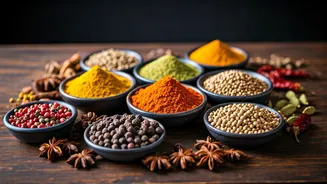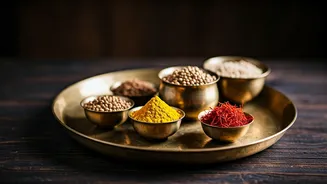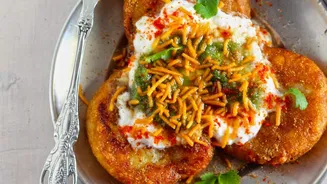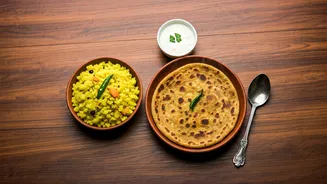Origins of Flavor
The roots of Indian cuisine trace back thousands of years, evolving alongside the Indian subcontinent's rich history and diverse cultures. Influences from
various civilizations, including the Mughals, Persians, and British, have shaped the culinary landscape. Spices played a crucial role, with the spice trade connecting India to the world and influencing international cuisine. The use of various cooking methods, such as tandoor, dum pukht, and tadka, along with the combination of different ingredients, contributed to the distinctive tastes. Each region boasts unique characteristics influenced by geography, climate, and local traditions, making Indian cuisine a complex tapestry of flavours, textures, and culinary practices. Throughout history, food has served as a cultural connector. The dishes prepared also depend on the religion or the region, which has led to a varied cuisine across the country. India has always been a land of variety and the origin of spices and has always been a hub for food lovers.
Regional Specialties Explored
India's culinary diversity mirrors its geographic variety, with each region offering unique dishes. North Indian cuisine is known for its rich gravies, creamy curries, and tandoor-cooked meats, often influenced by Mughal traditions. Dishes like butter chicken, biryani, and various types of parathas are staples. South Indian food is characterized by its reliance on rice, lentils, and the use of coconut, tamarind, and curry leaves. You'll find delicious dosas, idlis, and sambar. West India's cuisine highlights the coastal influence, with seafood taking a prominent role, in addition to the use of spices. Goan vindaloo and Gujarati thalis are some examples. East Indian cuisine embraces the use of mustard oil and features dishes like Bengali fish curries and Bihari litti chokha, with a focus on freshwater fish. The diversity and uniqueness of these flavors demonstrate how regional food adds to the wide culture of India.
Essential Cooking Techniques
Mastering Indian cooking involves understanding the key techniques that bring out the true flavors of the dishes. The art of tempering, also known as tadka, involves heating oil or ghee with spices to release their aromatic essence before adding them to a dish. Grinding spices, either by hand or using a grinder, freshly prepared spice mixtures are crucial for a burst of flavour. Slow cooking methods, such as 'dum' cooking, which involves cooking food in a sealed pot over low heat, are common. This allows the flavours to meld beautifully. Tandoor cooking, which involves using a clay oven, is popular for giving a smoky flavour to meats and bread. Understanding these essential techniques will significantly enhance the authenticity and taste of the Indian dishes you create. Indian cooking techniques, which are also influenced by the availability of food across regions, are the key to the amazing dishes.
Spice Blends and Their Uses
Indian cuisine owes its unique flavour to carefully curated spice blends. Garam masala, a blend of roasted and ground spices like cardamom, cinnamon, cloves, and peppercorns, is a staple. Curry powder, a British adaptation, is a common substitute, but authentic dishes use freshly ground spice mixes for flavour. Tandoori masala, used for marinating meats, typically includes ginger-garlic paste, turmeric, and chili powder. Each spice has a purpose, from adding heat to creating aroma. Coriander seeds are common in most blends and add to the flavour. Experimenting with spice combinations based on regional recipes can result in some extraordinary dishes. The use of spices makes Indian food truly a world favourite and the use of the different blends is an art in itself.
Recreating Authentic Dishes
To recreate authentic Indian dishes, start with fresh, quality ingredients and proper preparation. Begin by gathering the necessary spices and ingredients. Then, follow the recipes by carefully following instructions for preparing masalas, tempering spices, and cooking the food to perfection. Pay attention to the cooking times and the use of appropriate techniques, as each step significantly impacts the final taste. Don't hesitate to adapt recipes to suit your preferences, but maintain the basic structure of the dish. Experimentation is important, and you can add spices according to your taste. Start with simple dishes like dal or vegetable curries and gradually progress to complex ones. With patience and practice, you can bring the incredible flavours of Indian cuisine to your kitchen. The effort you put in will be worth it.













